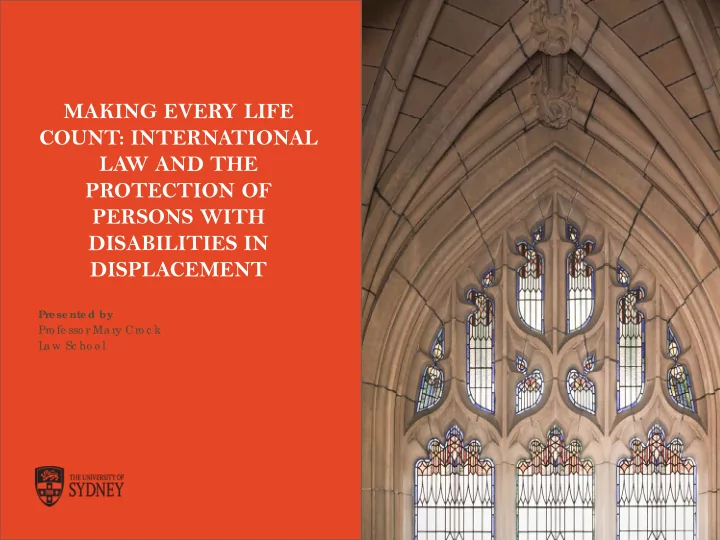

MAKING EVERY LIFE COUNT: INTERNATIONAL LAW AND THE PROTECTION OF PERSONS WITH DISABILITIES IN DISPLACEMENT Pr e se nte d by Pro fe sso r Ma ry Cro c k L a w Sc ho o l
Syrian IDPs, Aljazeera News
Turkey-Syria border, August 2014 Syrian border, Southern Turkey
CONVENTION RELATING TO THE STATUS OF REFUGEES 1951, AS AMENDED BY THE 1967 PROTOCOL Article 1A(2) A refugee is someone who: “owing to well-founded fear of being persecuted for reasons of race, religion, nationality, membership of a particular social group or political opinion, is outside the country of his nationality and is unable or, owing to such fear is unwilling to avail himself of the protection of that country…”
CONVENTION RELATING TO THE STATUS OF REFUGEES 1951, AS AMENDED BY THE 1967 PROTOCOL Article 33(1) Prohibition of expulsion or return (“refoulement”) “No Contracting State shall expel or return (“refouler”) a refugee in any manner whatsoever to the frontiers of territories where his life or freedom would be threatened on account of his race, religion, nationality, membership of a particular social group or political opinion.”
Laura Smith-Khan meets Disabled Persons Organisations, Islamabad, Pakistan, 2013 Mary, Ben and Laura, meet Ugandan National Association of the Deaf, Mbarara, 2013
CONVENTION ON THE RIGHTS OF PERSONS WITH DISABILITIES Article 11 – Situations of risk and humanitarian emergencies “States Parties shall take, in accordance with their obligations under international law, all necessary measures to ensure the protection and safety of persons with disabilities in situations of risk, including situations of armed conflict, humanitarian emergencies and the occurrence of natural disasters.”
CONVENTION ON THE RIGHTS OF PERSONS WITH DISABILITIES Article 1 – Purpose “…to promote, protect and ensure the full and equal enjoyment of all human rights and fundamental freedoms by all persons with disabilities, and to promote respect for their inherent dignity. Persons with disabilities include those who have long-term physical, mental, intellectual or sensory impairments which in interaction with various barriers may hinder their full and effective participation in society on an equal basis with others”
WASHINGTON GROUP ON DISABILITY STATISTICS Washington Group Short Question Set 1. Do you have difficulty seeing, even if wearing glasses? 2. Do you have difficulty hearing, even when using a hearing aid? 3. Do you have difficulty walking or climbing steps? 4. Do you have difficulty remembering or concentrating? 5. Do you have difficulty with self-care, such as washing all over or dressing? 6. Using your usual (customary) language, do you have difficulty communicating (for example, understanding or being understood by others)?
Urban refugee fieldwork, Kuala Lumpur, Malaysia, 2012
MALAYSIA QUESTIONNAIRE – OPEN QUESTION VS WASHINGTON GROUP QUESTIONS Comparing those who mentioned specific difficulties when asked an initial open question “Do you have a disability? Describe” with information only obtained in follow-up specific Washington Group questions Se lf Ca re F ine Mo to r Gro ss Mo to r Co g nitive Re spo nse to o pe n Q Me ntio ne d Unme ntio ne d Re spo nse o nly to spe c ific Q Co mmunic a tio n Mo b ility He a ring Visio n 0 20 40 60 80 100 120
UNHCR DATA VS WORLD HEALTH ORGANISATION DISABILITY PREVALENCE ESTIMATE 18.00% 16.00% 15.60% 14.00% 14.97% 12.00% 10.00% 8.00% 6.00% 4.00% 2.00% 0.46% 0.21% 0.00% WHO Pa kista n Ug a nd a Ma la ysia e stima te (PPVR) (Pro Gre s) (Pro Gre s) (a d ult) (a d ult) (a ll) (a ll)
Nakivale Settlement, Uganda, 2013
Countr y of Inc ide nc e of se xua l Suspe c te d None me ntione d or ig in/ Ge nde r viole nc e # % # % # % 76 24.20% 19 6.05% 219 69.75% Bur undi 31 19.50% 7 4.40% 121 76.10% F e ma le 46 29.87% 12 7.79% 96 62.34% Ma le Unspe c ifie d 0.00% 0.00% 2 100.00% DRC 89 21.34% 21 5.04% 307 73.62% F e ma le 63 28.64% 9 4.09% 148 67.27% Ma le 26 13.47% 12 6.22% 155 80.31% Unspe c ifie d 0.00% 0.00% 4 100.00% 10 11.24% 4 4.49% 75 84.27% Rwa nda 4 9.09% 2 4.55% 38 86.36% F e ma le 6 13.33% 2 4.44% 37 82.22% Ma le 4 3.36% 10 8.40% 105 88.24% Soma lia 2 3.13% 8 12.50% 54 84.38% F e ma le 2 3.70% 2 3.70% 50 92.59% Ma le Unspe c ifie d 0.00% 0.00% 1 100.00% South Suda n 1 25.00% 0.00% 3 75.00% F e ma le 1 50.00% 0.00% 1 50.00% Ma le 0.00% 0.00% 2 100.00% 2 7.41% 2 7.41% 23 85.19% Unspe c ifie d 1 6.67% 1 6.67% 13 86.67% F e ma le 0 0.00% 1 10.00% 9 90.00% Ma le 0.00% 0.00% 1 100.00% Unspe c ifie d 182 18.76% 56 5.77% 732 75.46% T ota l
Za’atari & Azraq Camps, Jordan, 2014
Nizip 2 Camp, Turkey, 2014
http://blogs.usyd.edu.au/refugees-disabilities/
Recommend
More recommend